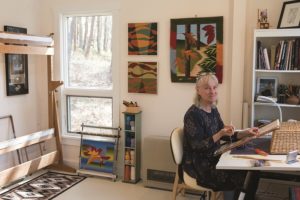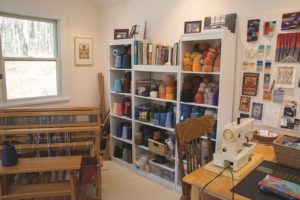My studio was a gift from my parents. It was built in 2017 with an inheritance I received after my mom and dad both died within four months of each other. I know my mom would say that she couldn’t think of a better way to use her money, and my dad would agree.
Also known as the “weaving shed” (and sometimes called the “she shed” by my husband), the studio is nestled in our back yard and faces north. It was designed by our friend Pat Woodbury, and built by another friend, Paul Renaud, both excellent craftsmen, to which this sweet structure bears witness.
I am a weaver. I became interested in weaving as a teenager, when I first saw a loom in the living room of my aunt’s house. A few years later, fresh out of college without much of a plan, I asked her to teach me to weave. She did, and I have been weaving ever since.

A weaver needs looms to weave on. For some reason, just one is never enough. Some of the looms I use for tapestry weaving, my primary medium, are small. Several, however, are more like pieces of furniture. Over the 15 years we have lived in Wellfleet, the looms kept taking up more space in the house. They needed a room of their own.
A weaver also needs lots of yarn, and that takes up space, too. One of the great joys of moving into the studio was finally being able to get all that yarn out of plastic bins kept in the basement. Now, it lives on shelves, where I can actually see what I have. Ideas for weavings often begin with time spent looking at the “yarn wall,” maybe seeing a color combination I hadn’t thought of before and imagining the possibilities.
Weaving is both a craft and an art. The weaving that I do on my floor loom is more craft. On that loom I make functional things, like scarves, dish towels, and baby blankets. Tapestry weaving, however, has a long tradition as a visual art form. It is an image-making medium, and produces a textile in which the image itself is integral to the woven object. In other words, the threads that create the picture also create the structure of the textile, the warp and the weft. Tapestries are woven on some kind of frame, large or small, that holds the vertical threads (the warp) through which the horizontal threads (the weft) are woven, over and under.

I have spent a lot of time in the studio during these strange recent months of staying at home. I have tried to maintain a practice of weaving every day, but some days that doesn’t happen. I have sewn face masks, some for the Medical Reserve Corps of Cape Cod, and some to keep family and friends safe. On the days when it is hard to focus on weaving, it is somehow easier to cut, iron, and stitch up five more masks.
Weaving is not my profession, though I exhibit my work when I can, and have occasionally sold pieces. I am an elementary school teacher, the math specialist at Truro Central School. Since mid-March, I have had to learn a whole new way of teaching, which involves spending most of my time on a computer and none of my time with children. When I close up my computer at the end of a “school day,” it’s time to leave the house. I walk a short distance across the patio and enter a space that brings me back to a more familiar sense of myself. There is always something to work on there, something I put down the day before and can pick up again. It helps, a lot.



